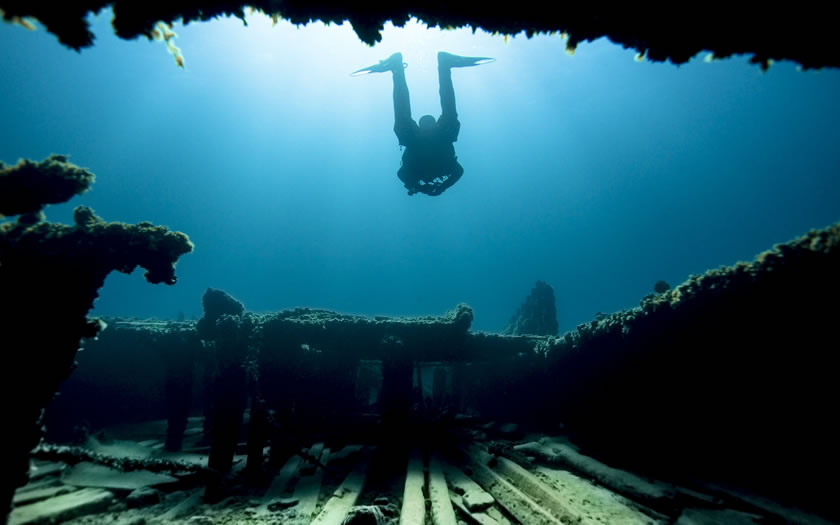The Thunder Bay National Marine Sanctuary is a protected underwater nature reserve in the northeastern region of Michigan.
The protected area holds a remarkable collection of around 100 historically significant shipwrecks, ranging from 19th-century wooden side-wheelers to 20th-century steel-hulled steamers.
The area was often referred to by sailors as 'Shipwreck Alley' because of the rocky shallows and the unpredictable weather. The sanctuary offers a unique glimpse into maritime history and is a vital part of America's underwater cultural heritage.

Paddleboarding in Thunder Bay National Marine Sanctuary
Photo: Bryan Dort/NOAA
The Thunder Bay National Marine Sanctuary is located off the shores of Alpena County in Michigan and has expanded north and south into neighboring counties to now cover an area of 4,300 square miles in Lake Huron.
It was the first national marine sanctuary established in the Great Lakes region.

Location of Thunder Bay National Marine Sanctuary
The closest settlement to the Marine Sanctuary is the town of Alpena and it makes sense to base yourself here if you are planning a trip to Thunder Bay.
Most people drive to Alpena, which is accessible via U.S. Route 23 along the Lake Huron coastline. This route, also known as the Huron Shores Heritage Route or the Sunrise Coast, offers scenic views of the lake along the way.
More details about other forms of travel to the area and accommodation options are on our Alpena Visitor Guide page.
The Thunder Bay National Marine Sanctuary was officially designated in 2000. The protected area aims to conserve and safeguard underwater cultural heritage sites, especially its significant collection of shipwrecks.
The area was first recognized as the Thunder Bay Underwater Preserve in 1981 by Michigan's "Bottomlands Act".
Initially the protected area just extended westwards from the northern and southern borders of Alpena county, with a size of just under 450 square miles.
The marine preserve was expanded to ten times that size in 2014. The expanded boundaries of the 4,300 square miles of protected area now include the waters of Lake Huron adjacent to the counties of Alcona, Alpena, and Presque Isle up to the international border.
The expansion allowed the preserve to improve the level of protection for wrecks along the Lake Huron coastline. The expansion increased the number of wrecks in the preserve from 52 to 99 (although historic records show there may be as many as 100 still to be discovered).
It also increased the area available for research into natural phenomena such as the sinkholes.
Some giant sinkholes, for example, are more than 300 feet across and up to 60 feet deep. Current research suggests that they may add water to the lake.
The sanctuary is managed by a collaboration between the NOAA and the State of Michigan. Thunder Bay National Marine Sanctuary is one of 14 sites managed by NOAA’s Office of National Marine Sanctuaries, and the only one in the Great Lakes.

Wreck Of DM Wilson
Photo: David J. Ruck/NOAA
The regulations expanding the preserve explained the importance of the Thunder Bay wrecks as follows:
Thunder Bay National Marine Sanctuary offers plenty of activities for both outdoor enthusiasts and history buffs.
Visitors can explore shipwrecks, enjoy scenic boat tours, and immerse themselves in local culture through museums and festivals.
Thunder Bay's clear, cold waters provide excellent conditions for diving and snorkeling.
The sanctuary is home to nearly 100 historic shipwrecks, accessible to divers of all skill levels.
Some wrecks lie in shallow waters, perfect for snorkeling, while others are deeper, challenging even seasoned divers.

Wreck Of Van Valkenburg
Photo: David J. Ruck/NOAA
Boat tours, especially glass-bottom boat tours, offer a unique way to view the underwater treasures of Thunder Bay without getting wet. These tours allow passengers to see shipwrecks clearly through the boat's transparent bottom.
The sanctuary’s calm waters are usually ideal for kayaking. Paddlers can explore the coastline and experience the sanctuary's natural beauty and sights at close hand.

The Alpena Shipwreck Tour available on the Lady Michigan
Alpena boasts several museums that deal with the maritime history of the region.
The Great Lakes Maritime Heritage Center in the Thunder Bay National Marine Sanctuary complex offers exhibits on shipwrecks and the area's nautical past. The Heritage Center is open daily.

Thunder Bay National Marine Sanctuary visitor center
Photo: NOAA
The Besser Museum covers local history which includes a Great Lakes Fisheries Heritage exhibit.
Alpena also hosts an annual film festival that showcases documentaries and films related to maritime heritage and underwater exploration.
Visit Alpena : www.visitalpena.com
Besser Museum: www.bessermuseum.org
Thunder Bay National Marine Sanctuary: thunderbay.noaa.gov
(See link above for the Great Lakes Maritime Heritage Center in Alpena)